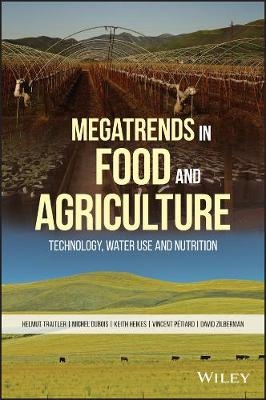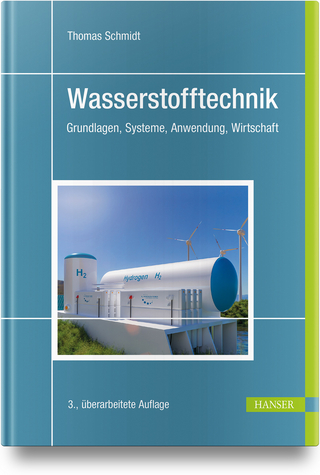
Megatrends in Food and Agriculture
John Wiley & Sons Inc (Verlag)
978-1-119-39114-2 (ISBN)
This is the first book of its kind to connect food and the food industry with agriculture, water resources, and water management in a detailed and thorough way. It brings together a small community of expert authors to address the future of the food industry, agriculture (both for plants and animals), and water—and its role in a world of increasing demands on resources.
The book begins by highlighting the role of agriculture in today's food industry from a historical perspective—showing how it has grown over the years. It goes on to examine water management; new ways of plant breeding not only based on genetic modification pathways; and the attention between major crops (soy, corn, wheat) and so-called "orphan crops" (coffee, cocoa, tropical fruits). The book then turns towards the future of the food industry and analyzes major food trends, the new food, and "enough" food; discusses possible new business models for the future food industry; and analyzes the impact that the "internet of everything" will have on agriculture and the food industry. Finally, Megatrends in Food and Agriculture: Technology, Water Use and Nutrition offers scenarios about how agriculture, food, and the food industry might undergo some radical transformations.
Assesses the evolution of food production and how we arrived at today's landscape
Focuses on key areas of change, driven by both innovation and challenges such as new technologies, the demand for better nutrition, and the management of dwindling resources
Highlights the role of better-informed consumers who demand transparency and accountability from producers
Is written by industry insiders and academic experts
Megatrends in Food and Agriculture: Technology, Water Use and Nutrition is an important resource for food and agriculture industry professionals, including scientists and technicians as well as decision makers, in management, marketing, sales, and regulatory areas, as well as related NGOs.
HELMUT TRAITLER, "Senior Innovation Connector" for Swissnex San Francisco, California, United States. MICHEL DUBOIS, UniLaSalle, Beauvais, France. KEITH HEIKES, Chief Executive Officer, Cooperative Resources International, Wisconsin, United States. VINCENT PÉTIARD, Founder of Plant Sciences and Technology Corporate R&D at Nestlé, France. DAVID ZILBERMAN, Professor who holds the Robinson Chair in the Department of Agricultural and Resource Economics, University of California at Berkeley, United States.
Foreword xiii
Acknowledgments xv
Part 1 Agriculture and the Food Industry 1
1 The Role of Agriculture in Today’s Food Industry 3
1.1 Introduction 3
1.1.1 The Four Building Blocks 4
1.1.2 Some History of Agriculture 5
1.1.3 Eat More and Increase the Likelihood for Survival 6
1.1.4 Food Can Be Grown and Plants Can Be Bred: What’s Next? 7
1.1.5 From Very Old to Rather Recent Food]Preservation Techniques 9
1.2 Agriculture: The Main Supplier to the Food Industry 10
1.2.1 Artificial Ingredients 10
1.2.2 The Main Raw Material Sources 11
1.2.3 Milk’s the Star 12
1.2.4 Milk…What Else? 13
1.2.5 Other Excursions from Food 14
1.2.6 Noncompeting Alternatives 15
1.3 Agriculture’s New Role in Light of Food and Health 16
1.3.1 Decades of Food Safety Rules and Regulations 18
1.3.2 More Rules: What Do We Do? 20
1.3.3 Raw Materials and Processes Become More Sophisticated 21
1.4 Most Likely Drivers for Change in the Agriculture Industry 23
1.5 Summary and Major Learning 25
References 27
2 Water Management in Modern Agriculture: The Role of Water and Water Management in Agriculture and Industry 29
2.1 Introduction 29
2.2 Multiple Dimensions of Water 30
2.3 On the Evolution of Water Institutions and Policies 33
2.4 Reforming Water]Resource Management at the Micro]Level (Farm and Field) 35
2.5 Reforming Regional Water]Allocation Regimes 38
2.6 Improved Water Project Design 42
2.7 Improved Water Quality 43
2.8 Climate Change 44
2.9 Summary and Major Learning 46
References 47
3 Innovation in Plant Breeding for a Sustainable Supply of High]Quality Plant Raw Materials for the Food Industry 53
3.1 Introduction 53
3.2 Challenges for Future Agricultures and Food Industries 54
3.2.1 Strongly Growing Food Needs 54
3.2.2 Energy Issues 56
3.3 Genetic]Based Techniques for Plant Breeding in the Context of Agricultural Production 59
3.3.1 Genetic Innovation and Agronomic Practices 59
3.3.2 The Process of Plant Breeding and Its Main Limitations 61
3.3.3 Preliminary Conclusions 67
3.4 Trends: Shift in Allocation of Resources to Global Needs? 68
3.4.1 Methodology 68
3.4.2 Analysis of Investment in Seed Research and Development 69
3.4.3 Analysis of Deviations and Distortions of R&D Investments and Production Volumes 71
3.5 A First Set of Conclusions and Recommendations 77
3.6 Summary and Major Learning 80
3.7 Appendix Tables 81
References 85
4 The Agriculture of Animals: Animal Proteins of the Future as Valuable and Sustainable Sources for the Food Industry 87
4.1 Livestock and Animal Husbandry 87
4.1.1 How We Got to Now 88
4.2 Animals: A Source of High]Quality Proteins 89
4.3 Animal Protein Demand in Emerging Markets 90
4.4 Optimal Animal Welfare: Sustainable, Humane, and Healthy 93
4.4.1 Animal Production Increase 95
4.5 Animal]Breeding Programs 97
4.5.1 Genomic Breeding of Animals 98
4.6 The Use of Big Data for Management and Genetic Evaluations 102
4.7 Summary and Major Learning 106
References 108
Part 2 The Future of the Food Industry 109
5 The Food Trends—The New Food—Enough Food? 111
5.1 Historical Food Trends: From Then to Now 111
5.1.1 Food and Beverages during the Period of Classical Greece 111
5.1.2 Food and Beverages in the Roman Empire 113
5.1.3 Food in Medieval Times in Central Europe 115
5.1.4 From European Renaissance and Enlightenment to the First Industrial Revolution 118
5.1.5 Food in the 20th Century: The Real Food Revolution 121
5.2 Present]Day Food Fashions and Trends: A Never]Ending Story 124
5.2.1 Food and Nutrition Trends: A Story of Perception, Deception, and Beliefs 125
5.3 New Food Sources: New Protein Sources 128
5.3.1 Insects: A New Food Source? 129
5.3.2 Increased Food Security through Exploiting New Protein Sources 130
5.3.3 A “Crazy” Idea for Other Food Sources: Beyond Proteins 131
5.4 Vegetarian Food and Its Potential Societal and Economic Impact 132
5.5 Urban Gardening and Urban Agriculture 134
5.5.1 The Urban Bee]Highways 136
5.6 Summary and Major Learning 137
References 138
6 The New Food Industry Business Model: From B2C to B2B, from Product Manufacture to Selling Know]How, and from Now to Then 141
6.1 The Old: Develop, Manufacture, and Sell (“Demase”) 141
6.1.1 The Fall of the Righteous 142
6.2 The New: The Customer Is King, the Consumer Is an Enabler, and from B2C to B2B 144
6.2.1 Slotting Allowance 145
6.2.2 Retailers Become the Most Important Partners for Food and Beverage Companies 146
6.2.3 How This Could Work: A Possible Path and Examples 147
6.3 From Selling Products to Selling Know]How 150
6.3.1 The Knowledge]Centric Company 152
6.3.2 Engaging, Interacting, and Selling: The New Etiquette 154
6.4 The Community of Consumers: It’s What They Want that Counts! 155
6.4.1 The Consumers Become Involved 158
6.5 Food]Related Trends and Hypes in Today’s Societies: An Outlook to the Future 161
6.6 Summary and Major Learning 163
References 165
7 The Internet of Just about Everything: Impact on Agriculture and Food Industry 167
7.1 Modern Cooking: Forward to the Past 167
7.1.1 The Role of Robotics and Connectivity 169
7.2 Everything Is Online and Everyone Is Online—All the Time 171
7.3 Food and Agriculture: The New Hardware and Software 174
7.3.1 Big Data Are Here to Stay 176
7.3.2 Agriculture and Space Science: The New Connection 176
7.3.3 Impact on the Food Industry and the Consumer in the Middle 178
7.4 An Attempt at Peaking Ahead: Will There Still Be an Agriculture or Food Industry? 179
7.4.1 Bigger Is Not Always Better 180
7.4.2 Elements that Will Stay and Others that Might Disappear 182
7.5 Summary and Major Learning 186
References 189
8 Nutrition: The Old Mantra … the New Un]Word 191
8.1 Nutrition: What’s All the Fuss about? 191
8.1.1 The Hottest New Food Trends 192
8.1.2 The Debate Continues: What’s Good and What’s Not Good for You? 195
8.1.3 And Here We Go Again: Fasting Can Do You an Awful Lot of Good 196
8.1.4 A Few Simple Tips When It Comes to Healthy and Happy Eating 197
8.2 A Bit of Nutrition History 198
8.2.1 Low and Reduced, Lower and “Reduced]Er”: Low or Reduced Fat 202
8.2.2 Low or Reduced Salt 203
8.2.3 Low or Reduced Sugar and No Sugar 204
8.2.4 Low Saturated Fats, Good Monounsaturated Fats, More Polyunsaturated Fats, and Lots of Ω3 Fats 206
8.3 Typical Nutrition Controversies 208
8.3.1 So Many Recommendations…Too Many? 208
8.3.2 More Controversies 210
8.4 Food and Claims, Food and Benefits 211
8.5 Summary and Major Learning 214
References 217
Part 3 The New Food World 219
9 A Food Company Transforms Itself 221
9.1 The Not]So]New Realities 221
9.1.1 Automation Is Here…For Quite Some Time Actually 223
9.1.2 The Novel Directions in Food and Agriculture are Governed by Regulatory Involvement 225
9.1.3 All]Natural Industrial Food Products: The Way Forward? 226
9.2 From Product to Know]How Seller: An Encore 227
9.2.1 Some Assumptions as to How This May Function 228
9.2.2 What are Possible Consequences for Food Ingredient Suppliers? 230
9.3 Anticipating the Inevitable: Possible Scenarios 234
9.3.1 Possible Future Models and Scenarios 238
9.3.2 The Return Of Medical Food? 239
9.4 Reality or Fiction? Reality and Fiction! 241
9.4.1 A New Manufacturing Reality 242
9.5 Summary and Major Learning 244
References 246
10 Food for the Future: A Future for Food 247
10.1 Proactive Agriculture 247
10.1.1 What If Agriculture Anticipated Real Food Requirements and Trends? 249
10.2 Democratized Agriculture 252
10.2.1 Agrihood 253
10.2.2 Permaculture 254
10.2.3 From Large to Small 259
10.2.4 The Growing Role of Urban Agriculture: Self]Centeredness or Community Driven? 261
10.3 Agriculture and Food Manufacture in Exotic Places 264
10.3.1 An Ice Cream Factory in Greenland? 265
10.3.2 A Chocolate Factory in Ghana? 266
10.4 A Future for Food 269
10.4.1 What about the Role of Restaurants? 269
10.4.2 Pet Food Is Food, Too 270
10.4.3 Will We Eat Food in Pill Format? 271
10.5 Summary and Major Learning 273
References 274
11 Summary and Outlook 277
11.1 Introduction 277
11.1.1 The Role of Agriculture in Today’s Food Industry 278
11.1.2 Food]Preservation Techniques 279
11.1.3 Agriculture Is the Main Raw Material Supplier to Be Transformed to Food 280
11.1.4 Nonfood Uses of Agricultural Raw Materials 280
11.1.5 Agriculture in a World of Rules and Regulations 280
11.1.6 Food Raw Materials and Process Became More Sophisticated and Complex 281
11.2 Water Management in Modern Agriculture 281
11.2.1 The “Water Reform” 282
11.2.2 Water Productivity 282
11.2.3 Water]Related Government Policies 283
11.2.4 Getting It Right: Policies and Price 283
11.2.5 Controlling Water Quality 284
11.3 Innovation in Plant Breeding: High]Quality Plant Raw Materials for the Food Industry 285
11.3.1 Agricultural Plant Output: The Essential Raw Material Source for the Food Industry 285
11.3.2 Demand Forecast Based on Food Requirements 285
11.3.3 Genetic Improvement of Cultivated Crops 285
11.3.4 The Major Crops versus “Orphan Crops” 286
11.4 The Agriculture of Animals: Valuable and Sustainable Sources for the Food Industry 286
11.4.1 Growing Population: Growing Amount of Livestock 287
11.4.2 Animal Health and Intensive Farming 287
11.4.3 Animal Breeding 287
11.4.4 Good Farm Management: Good Data Management 288
11.5 The Food Trends—the New Food—Enough Food? 288
11.5.1 Food and Beverage Fashions and Trends of the Past 289
11.5.2 The “Real” Food Revolution of the 20th Century 289
11.5.3 Present]Day Food and Nutrition Trends 290
11.5.4 New Food Sources: New Protein Sources 290
11.5.5 Vegetarian Food and Its Impact on Society 291
11.5.6 The Role of Urban Agriculture and Bees 291
11.6 New Business Models for the Food Industry 292
11.6.1 From “Consumer Is King” to “Customer Is King”: Retailers Become Real Partners 292
11.6.2 Good]Bye to Selling Products and Hello to Selling Know]How 293
11.6.3 Consumers Become Involved 294
11.7 The Internet of Just about Everything and What This Means for Agriculture and Food 295
11.7.1 Modern Cooking: A Brief Look to the Past 295
11.7.2 Robotics and Connectivity 296
11.7.3 Food and Agriculture: Big Data 296
11.7.4 Will There Still Be Agriculture and Food Industries? 297
11.7.5 What Will Remain, and What Will Disappear? 297
11.8 Nutrition: What Else? 299
11.8.1 Healthy and Happy Eating 299
11.8.2 A Short History of Nutrition 300
11.8.3 Nutrition Controversies 301
11.8.4 Claims and Benefits 302
11.9 The Company Transforms Itself 302
11.9.1 The Role of Automation: Threat or Blessing? 303
11.9.2 Regulatory Involvement in the Industry 303
11.9.3 The New Business Model 2.1 304
11.9.4 Scenarios of Relevance for Food and Agriculture 304
11.9.5 Medical Food: A Future? 305
11.9.6 Reality or Fiction? 306
11.10 Agriculture Listens, Finally? 306
11.10.1 Agriculture and Farming at the Fingertips of Everyone 307
11.10.2 Small Is Beautiful 308
11.10.3 Is Urban Agriculture a Sign of Self]Centeredness or Is It Community Driven? 308
11.10.4 Manufacturing Food Where It Makes Sense 309
11.10.5 What Role Do Restaurants Play? 309
11.10.6 The Role of Pet Food in the Food Industry 310
11.10.7 Food in the Format of Pills? Will Consuming Food Pills Be Part of Megatrends? 310
Index 313
| Erscheinungsdatum | 17.02.2018 |
|---|---|
| Verlagsort | New York |
| Sprache | englisch |
| Maße | 155 x 231 mm |
| Gewicht | 680 g |
| Themenwelt | Naturwissenschaften ► Biologie ► Ökologie / Naturschutz |
| Naturwissenschaften ► Geowissenschaften ► Hydrologie / Ozeanografie | |
| Technik ► Lebensmitteltechnologie | |
| Weitere Fachgebiete ► Land- / Forstwirtschaft / Fischerei | |
| ISBN-10 | 1-119-39114-8 / 1119391148 |
| ISBN-13 | 978-1-119-39114-2 / 9781119391142 |
| Zustand | Neuware |
| Informationen gemäß Produktsicherheitsverordnung (GPSR) | |
| Haben Sie eine Frage zum Produkt? |
aus dem Bereich


